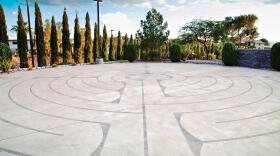A company linked to developer Jim Rhodes has revived his dream of building houses atop Blue Diamond Hill. Is this plan invincible?
As cameras jump from one Clark County planning commissioner’s face to the next, their sympathy with the community members who’ve just testified at the September 20 meeting becomes increasingly apparent.
“Her presentation was concise and brought up some incredibly valid points … that I hadn’t even thought of,” Commissioner Donna Tagliaferri says, apparently referring to UNLV civil engineering professor Barbara Luke, one of a dozen people to lodge complaints against a proposal to develop 5,000 homes on 2,000 acres atop Blue Diamond Hill in Red Rock.
After listening to his fellow commissioners hash out their concerns, J. Dapper, who represents Red Rock, interrogates Ron Krater, who represents the developer, about whether potentially affected community members had been involved in the plan’s formulation, and if not, why. “I can tell you right now that you don’t have my vote,” Dapper says, despite Krater’s assertion that the plan was publicly vetted. “This is my area, and what I’m saying is, I’d like to see you hold this and ... continue working on it.” He suggests a 90-day delay before voting on the application.
Just then, a large man standing near Krater at a podium facing the commission interrupts. We’ve been going for an hour and half, he says. How about a break?
This man is attorney Jay Brown, a political heavyweight tied to the likes of Harry Reid. As the video continues running during the break, Brown can be seen conferring with various commissioners and county staff.
When the meeting reconvenes, the tone has changed. Some commissioners now suggest approving Krater’s application and letting the community give feedback as the plan unfolds.
“You could require, as part of the specific plan process, that they get the input that you would be satisfied with,” Tagliaferri tells Dapper.
But he holds out, and a compromise is reached. Krater gets a month to meet with Blue Diamond, Mountain’s Edge, Red Rock and Rhodes Ranch communities and give notice that the application will be heard on October 18.
The results of that October meeting are below, but first, a little history. In the early 2000s, developer Jim Rhodes bought a 2,400-acre, 90-year-old gypsum mine on Blue Diamond Hill, across State Highway 159 from the small town of Blue Diamond. (Krater says the current developer, Gypsum Resources, is owned and controlled by a family trust and that Jim Rhodes is one of many stakeholders.)
The area is on federal land west of town known as Red Rock that’s managed by the BLM. Owners kept the private property — not just Blue Diamond, but also Calico Basin, Bonnie Springs and the Spring Mountain Ranch — that they owned before the 196,000-acre Red Rock National Conservation Area was designated in 1990. Clark County is in charge of zoning and construction on the private property in Red Rock.
[[field:story]]
Rhodes proposed building 7,000 houses atop Blue Diamond Hill, on land that sits on the outside edge of the conservation area. It is surrounded by undeveloped and/or heavily mined land. Residents of nearby communities joined forces with thousands of environmentalists and outdoor enthusiasts to fight the plan. In 2005, Blue Diamond resident Heather Fisher, who co-owns Las Vegas Cyclery and Escape Adventures (which profit from Red Rock tours) helped found Save Red Rock, a nonprofit represented pro bono by attorney and former State Senator Justin Jones.
“Blue Diamond Hill is the barrier that blocks the noise, traffic and haze from Las Vegas. It keeps Red Rock dark, quiet, peaceful — all the things that thousands of visitors come out here every weekend to enjoy,” Fisher says. “If you build a city on top of it, you’re breaching that barrier.”
For his part, Rhodes sued the state and county, saying passage of a 2003 state law forbidding high-density development in Red Rock violated his property-owner rights. The county settled, but the state took it to court. In 2013, the Nevada Supreme Court agreed with Rhodes that the state had overstepped its bounds.
By then, the county and Rhodes had settled. In 2011, they agreed on a concept with more than a dozen conditions: no connector road from the 159 up the hill, low-density housing, natural colors, dark-sky lighting and so on. Due to the fierce local opposition to the project, Rhodes also agreed to try and swap some of his land on Blue Diamond Hill for BLM property in a less objectionable area. In 2014, that effort stalled when the BLM said its policy was to not take over land as ravaged as the former mining area.
Then, to hear opponents tell it, things went quiet. That is, until September 20. After winning their postponement from the planning commission, the opposition got busy. Save Red Rock started a petition against the rezoning that it says garnered 19,000 signatures. At the October 18 hearing, dozens of well-prepared opponents lined up to testify to a multitude of negative impacts they expect the project to have — from a drop in recreational tourism to a spike in traffic in the area. After minimal deliberation, commission chair Dan Shaw moved to recommend denial, and a vote on the motion passed unanimously.
The next step is the County Commission meeting on December 7. The commission will consider Gypsum Resources’ application and concept plan, taking into account the planning commission’s and Red Rock Community Advisory Council’s advice to deny.
But in a town built on gambling and construction, odds favor developers.
“I sympathize with people who would like to see just nature, open space,” Krater says. “But it was never going to be that. … Every square inch of that property could be developed. This proposal suggests an alternative to that.”
Indeed, the new concept, scaled back from Rhodes’ original proposal, incorporates the conditions the county previously demanded. Commissioner Susan Brager, whose district includes Red Rock and who was Save Red Rock’s biggest ally last time around, is serving her final term, so voters have lost reelection leverage with her. And, perhaps most daunting, Gypsum now has Jay Brown on its side.
“Over the last few days, I’ve had conversations with people asking, ‘How do you beat Jay Brown?’ and people just shake their heads,” attorney Jones says.
But as the October 18 meeting showed, Jones has a few tricks up his sleeve, such as pointing out Gypsum’s lack of contiguous parcels for a coherent design, a county requirement. And the project’s enormous unpopularity could have political ramifications beyond the district and term in question.
Fisher was energized following Save Red Rock’s October 18 win: “We will now take the fight to the Clark County Commission, where we hope that they will show the same courage in standing up for the people and for Red Rock Canyon that the Planning Commission showed.”









